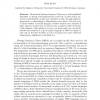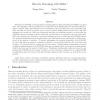1031 search results - page 196 / 207 » The single-serving channel capacity |
134
click to vote
FOSSACS
2001
Springer
15 years 4 months ago
2001
Springer
Hierarchical Message Sequence Charts are a well-established formalism to specify telecommunication protocols. In this model, numerous undecidability results were obtained recently ...
152
click to vote
STOC
1997
ACM
15 years 4 months ago
1997
ACM
We present randomized constructions of linear-time encodable and decodable codes that can transmit over lossy channels at rates extremely close to capacity. The encoding and decod...
CORR
2008
Springer
14 years 12 months ago
2008
Springer
Equivocation has been widely used as a measure of security after Shannon[10]. For an infinite system such as the wiretap channel defined in [2], equivocation is unbounded and so e...
CORR
2007
Springer
14 years 12 months ago
2007
Springer
We consider asynchronous communication over point-to-point discrete memoryless channels without feedback. The transmitter starts sending one block codeword at an instant that is u...
CORR
2007
Springer
14 years 12 months ago
2007
Springer
We introduce S-DUDE, a new algorithm for denoising Discrete Memoryless Channel (DMC)-corrupted data. The algorithm, which generalizes the recently introduced DUDE (Discrete Univer...


